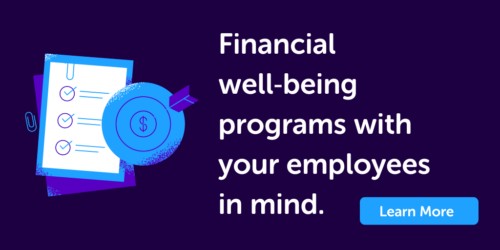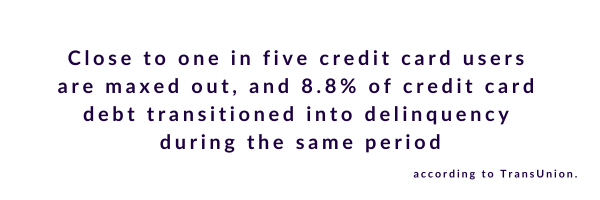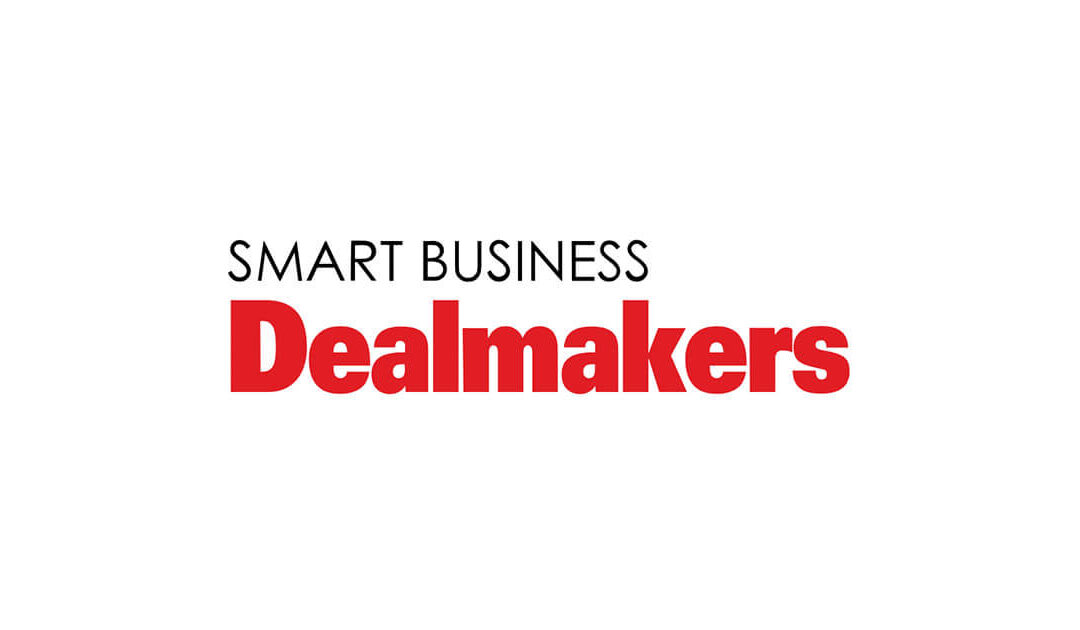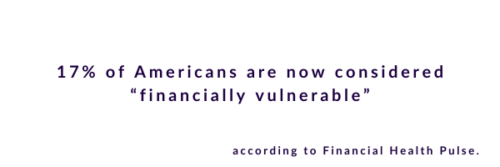The State of American Financial Wellness and Financial Stress, 2022. The Covid-19 pandemic changed Americans’ relationship to their personal finances. Here are the top financial wellness and financial stress highlights from 2022.
The Covid-19 pandemic has dramatically changed Americans’ relationship to their personal finances. Study after study has found that more than half of Americans live paycheck-to-paycheck. One- third of those earn more than $100,000 per year, but still struggle to make ends meet. Indeed, midway through 2022, a new survey found that nearly one in three consumers earning $250,000 or more annually is living paycheck-to-paycheck.[1] Another study[2] found that 75% of U.S. employees are facing at least one source of major financial stress and are spending 9.2 work hours per week dealing with their finances.
Globally, consumers face extremely high rates of inflation while food, fuel and housing costs soar. Household debt climbed past $16 trillion in the second quarter, with credit card balances surging 13% in the past year. Rising interest rates strain pocketbooks, and that doesn’t include $1.6 trillion in student loan debt repayments, which have been suspended since the start of the pandemic, in 2020.
Clearly, personal financial stress is on the rise.

Generational Financial Stress
Americans from all generations struggle with financial stress: [3]
- 63% of all employees say their financial stress has increased since the pandemic started
- 42% of full-time employees struggle to pay household expenses on time each month
- When it comes to personal finances, 87% of employees want help and 84%[4] believe their employers should be responsible for their financial wellbeing.
But, it appears that younger workers are struggling more:[5]
- The majority of Gen Z and Millennials (about 70%) have high financial stress due to the pandemic;
- 29% of Gen Z says the cost of living (meaning housing, transportation and bills) is their most pressing concern and 46% say they live paycheck-to- paycheck;
- 72% of U.S. millennials carry some form of non-mortgage debt, with the average millennial owing $117,000;[6]
- 63% of Millennials believe it will take them one to five years to pay off their debt, 9% think it will take them more than 10 years, and 6% think they’ll never pay it off; [7]
- And while Millennials and Gen Z want to buy homes, Gen Z is currently unable to afford a median priced home in any of the top 100 markets. Millennials can only afford a median priced home in 34 of the biggest 100 metro areas.[8]
Millennials, Gen Z and Student Loan Forgiveness
A top concern for many Millennials is their looming student debt. About 30% of Millennials carry a student loan, and in many cases, these loans have affected their ability to meet financial goals.[9] Over 30% of Americans put off buying a home because of looming student debt, and almost 25% of Americans have limited their retirement and emergency savings due to outstanding student debt.[10]
In August, President Biden announced widespread student loan forgiveness up to $10,000 of debt for borrowers who earn less than $125,000 per year or married couples (or heads of households earning less than $250,000). An estimated 37 million Americans out of 45 million who hold student loan debt may be eligible.
While those eligible for student loan forgiveness will not have to pay federal income tax on the amount that is forgiven (which the IRS treats as a gift), more than a dozen states may impose state income tax on the forgiven amount.
Baby Boomers, Gen X and Financial Stress
Conversely, Baby Boomers tend to report the least amount of financial stress. In fact, just 14% of Baby Boomers say that debt has affected their quality of life, and more than half say they have control over their debts.[11]
Gen X falls somewhere in the middle. They carry looming debt and financial stress, but are working to dial it down. In 2021, almost 48% of Gen Xers reported a good or great sense of financial wellness, up from 38% in 2020. This is the largest percentage point increase for any generation for reported financial wellness.[12]
However, across all generations — from Gen Z to the Silent Generation — financial wellness and security during retirement remains a primary concern.[13]
Turnover, Retention & Financial Stress
There’s more bad news for companies struggling to keep employees. Several recent studies found that employees are more likely to look for a new job if they’re financially stressed.
- Financially-stressed employees are twice as likely to change jobs as those who aren’t;
- Among 44% of employees looking to change jobs[14], 65% say the reason is financial: they need more money;
- 76% of employees looking to change jobs would prefer to work for a company that cares about their financial wellbeing;
- 49% of employees have experienced a financial shock, including a significant medical expense (31%) followed by working hours cut (23%) fraud (15%) and the impact of divorce (13%).
Moreover, there’s a stark disconnect in what people want in financial wellness programs versus what they’re being given. Employers are well positioned to help change that.
Financially Stressed Employees Have Worse Health Outcomes
One of the most concerning elements of financial stress is the relationship to physical and mental health. People who are financially stressed are much more likely to struggle with substance abuse, be overweight and have worse health outcomes than their non-stressed peers. They’re also much less likely to be engaged at work. But with inflation running rampant, other cracks are emerging:
- One-third of those who find it difficult to afford healthcare deferred appointments or treatments and say their health suffered because of it;
- For employees whose financial stress increased over the pandemic, about 60% avoided seeking medical treatment due to high costs;
- Among financially-stressed employees, 49% said that money worries had a severe or major impact on their mental health in the past year.[15]
One way to improve workforce financial wellbeing is to help employees make a smarter decision about healthcare coverage. Best Money Moves’ partners have seen employees save an average of $1,300 per year simply by making better decisions based on actual claims data, while employers have seen usage go up and, in some cases, overall costs decline.
Financial Health of Americans
About 35 million Americans are estimated to be financially vulnerable, which means they’re struggling with almost all aspects of their financial lives. Comparatively, about 131 million Americans say they’re coping financially, while struggling with some aspects of their financial lives.[16]
Many societal and pandemic-related trends have shaped the financial challenges people face (e.g., rising costs of living, workplace instability, earning gaps, etc.).
Although almost 80% of Americans have an emergency fund, less than half can cover six months of expenses. And even those with high financial wellness, one in five cannot easily cover six months of expenses.[17] All of this paints a worrying picture of financial health for most Americans, especially with many economists forecasting a recession in 2023.
Employees want more than just retirement assistance
One of the most-requested benefits in 2022 is financial wellness support. Companies tend to only offer retirement plans and safety net insurance. Employees don’t think it’s enough.
Over 80% of employees want personal finance help from their employers, beyond the typical retirement plans and safety net insurance.[18] Employees need to learn basic money management and prefer to get money coaching, budgeting help and other resources that can help them achieve their financial goals.
The benefits are clear: employees who participate in financial wellness programs are twice as likely to have high financial wellness than those not offered such resources (32% vs. 15%).[19] The ROI for employers includes reduced turnover, improved retention and productivity, fewer workplace accidents and healthier employees, among other benefits.
Best Money Moves can help. Personalized, gamified and easy-to-use, Best Money Moves helps employees budget, make better financial decisions and implement their personal best money moves to achieve their most specific financial goals.
About Best Money Moves
Best Money Moves helps your employees measure and dial down their financial stress, with measurement tools, 900+ written and video resources, and best-in-class voluntary benefits to supplement those you already offer. Depending on the version chosen, you may be able to integrate your own company benefits into the platform, personalizing the financial wellness journey your employees are on. Call us for a demo and find out how adding a great financial wellness benefit can help improve retention, lower turnover and reduce healthcare costs.
To learn more about Best Money Moves Financial Wellness Platform, let’s schedule a call. Contact us and we’ll reach out to you soon.
1 New Reality Check: The Paycheck-To-Paycheck Report – Financial Distress Factors Edition, PYMNTS and LendingClub survey, 2022
2 https://www.sofi.com/sofi-at-work/workplace-2022/
3 2021 PwC Employee Financial Wellness Survey, PwC, 2021
4 https://www.sofi.com/sofi-at-work/workplace-2022/
5 https://www.forbes.com/sites/markcperna/2022/05/23/deloitte-almost-half-of-gen-z-workers-live-with-financial- anxiety-every-day/?sh=3ecd0cd97073
6 https://www.realestatewitch.com/millennial-debt-2022
7 https://www.realestatewitch.com/millennial-debt-2022
8 https://www.point2homes.com/news/us-real-estate-news/unaffordable-housing-by-generation-100-counties.html
9 https://educationdata.org/student-loan-debt-by-generation
10 https://www.cnbc.com/2021/04/08/older-millennials-with-student-debt-say-their-loans-werent-worth-it.html
11 https://business.bofa.com/content/dam/flagship/workplace-benefits/id20_0905/documents/2021-WBR.pdf
12 https://business.bofa.com/content/dam/flagship/workplace-benefits/id20_0905/documents/2021-WBR.pdf
13 https://business.bofa.com/content/dam/flagship/workplace-benefits/id20_0905/documents/2021-WBR.pdf
14 https://www.wtwco.com/en-US/Insights/2022/06/2022-global-benefits-attitude-survey
15 https://www.pwc.com/us/en/services/consulting/business-transformation/library/employee-financial-wellness- survey.html
16 https://fhn-finhealthnetwork-assets.s3.amazonaws.com/uploads/2021/10/2021_Pulse_Trends_Report.pdf
17 https://www.tiaa.org/public/pdf/2022_financial_wellness_survey_final_results.pdf
18 https://www.brightplan.com/2021-wellness-barometer-survey
19 https://www.tiaa.org/public/pdf/2022_financial_wellness_survey_final_results.pdf









